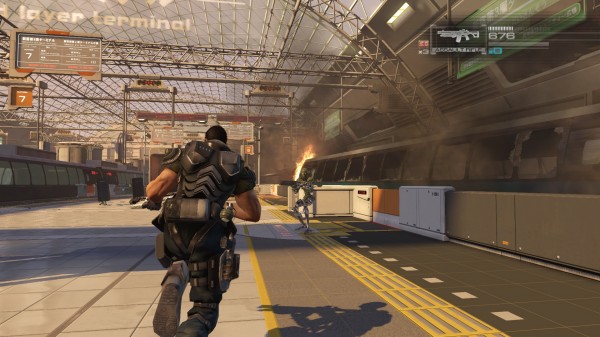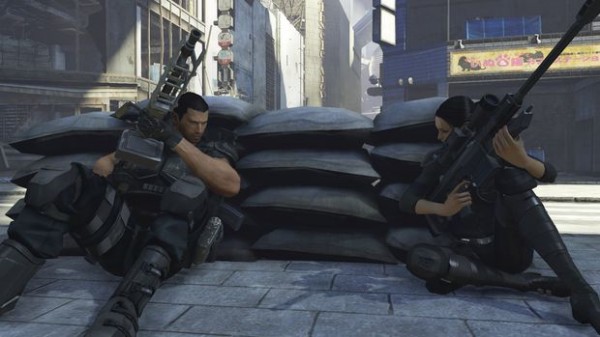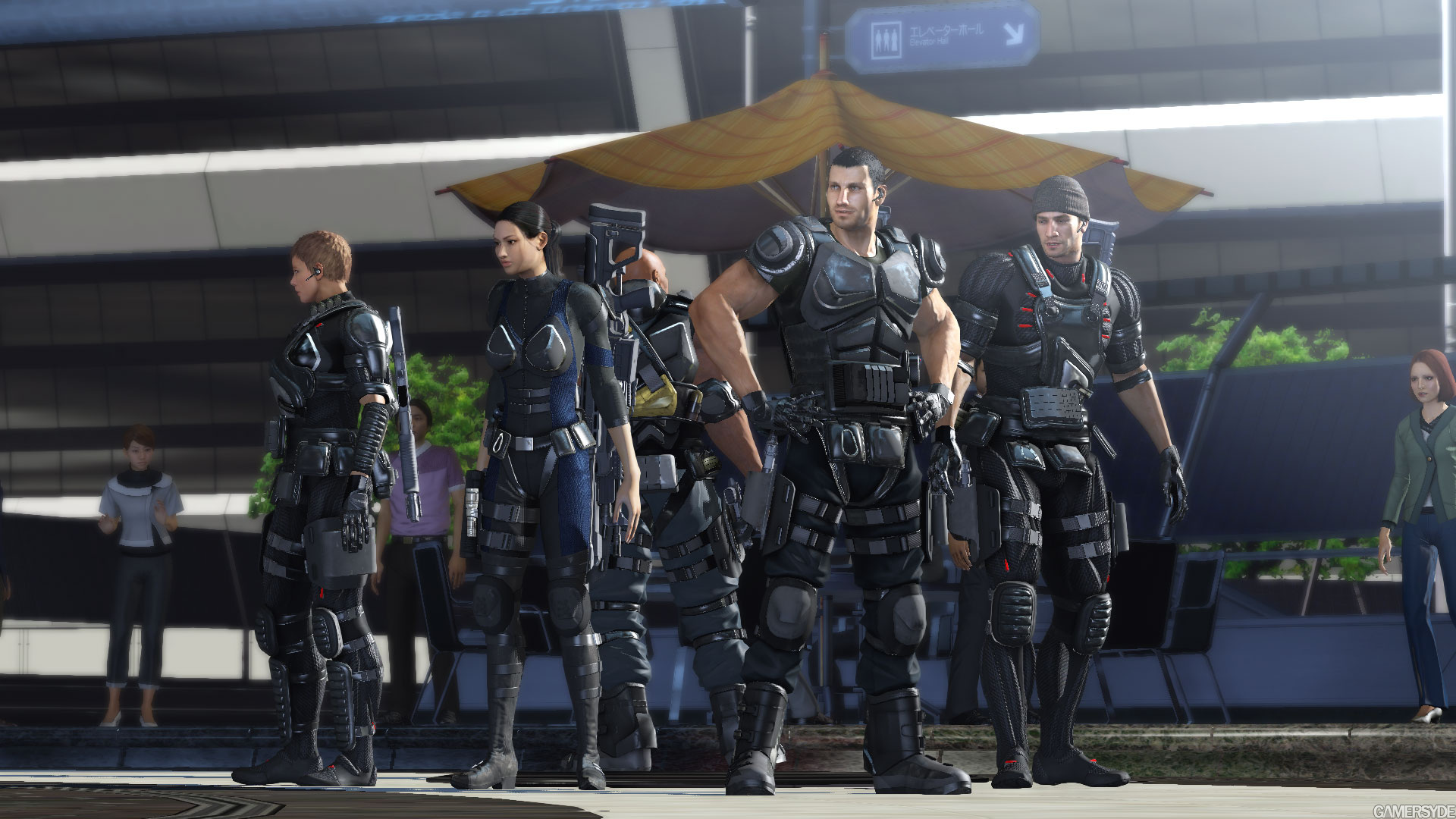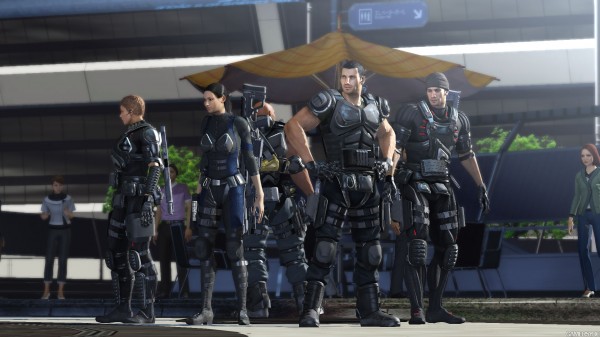
From the creator of the Yakuza series comes a Gears of War clone in a shiny new skin moulded from ‘I, Robot’, ‘Terminator’ and ‘Blade Runner’.
Developer: Yakuza Studio
Publisher: SEGA
S.A. Distributor: Ster Kinekor Interactive
For fans of: Third person action games who think all robots are evil.
Reviewed on: PlayStation 3.
Also available on: Xbox 360.
If we had to give it a numerical score: 7.0 out of 10
What I liked
- Solid third person action.
- Shooting robots is a nice diversion from shooting humans. And zombies.
- Nanomachine/Skills.
- Faye.
- Team loyalty/’Consequence’ sounds like a great idea…
Not so much
- … but is poorly implemented.
- Frustrating attempt to add social commentary to the game.
- Clichéd nationality types.
- Repetitive dialogue.
- Why are there weapon vending machines sitting on street corners?
Overview
It’s 2080AD and the world is still battling to follow rules. The Geneva Code, Clause 21 set up to prevent the creation of ‘Hollow Children’ – robots that believe they are human – has been broken. The naughty folk at the Amada Corporation in Tokyo are believed to be the culprits and you – an all-American-cliché-sort called Dan – and the rest of your ‘Rust Crew’ need to punish the bad guy. And kill a lot of ‘scrap-heads’ along the way.
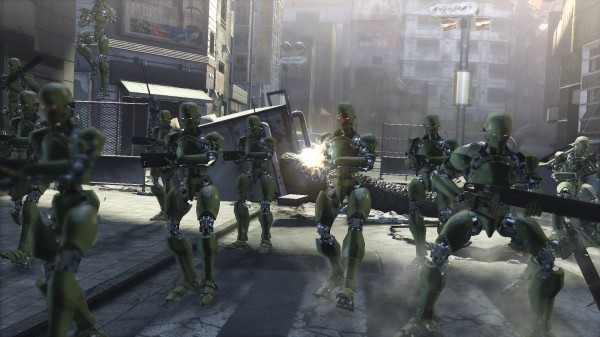
Gameplay and Features
The game has no great pretensions to greatness – except in its attempts at social and cultural commentary – but it also does do the major gameplay mechanic more than a passing justice. As a third person cover shooter it is brilliantly good fun. However, the gravy poured on it is grating to say the least.
The story is clearly trying to show a parallel with current prejudice and stereotypes and how we can, when faced with a common enemy find common ground. It does this by bludgeoning you with clichéd and stereotyped nationality types from America, China, Japan, Britain and France. Surprisingly, the game doesn’t appear to pitch the traditional British/French rivalry, but it does throw a spanner in the works for ‘scrap-head’ hating Dan when the French member of the team appears. For me, if this component of the game had been handled with more subtlety, the overall experience would have been infinitely better.
Moving on from my dislike for the sentiments of the story how does Binary Domain stack up as an action game then? Very well actually. It borrows from the third person cover shooter mechanic pioneered by Gears of War and Uncharted and leaves it virtually unchanged. Slide into cover, blind-fire, aim and fire and vault over cover are all present and correct. However, what the game brings to the table are squad mates. And squad mates you can boss around to boot.
Through the course of the story you meet up with the other nationalities of the ‘Rust Crew’ who become members of your merry crew. As you progress you can swop which squad mates you spend quality time with and try to improve your working relationship. This is where the game’s much spoken of (if you’ve been concentrating on the game pre-launch that is) ‘Consequence’ system comes in. The idea is that a team member loyal to you will follow your orders. A great idea in principle – but one that doesn’t quite get it right.
Loyalty is improved via conversations with your team mates – and to go along with the traditional button press to answer you can choose to answer with voice commands. Each character will positively react to the “correct” answer and when you generally prove your worth. Answer “hell yeah” when you’re asked if all women are meant to be in the kitchen and you’ll lose your team mates respect – except from your American companion… Shoot a team mate (accidentally even) and you lose respect. Of course, it doesn’t help that the companion AI can be so damn stupid at times to actually walk past you while you’re firing (or shove you out of cover for their own benefit). While the principle of the trust system is great, the reality is that the experience feels shallow, as you can gain positive street cred from your team mates by purely running around like Rambo. It should generally be pretty difficult to get a team mate to ignore you due to lack of trust unless you target them for some or other sadistic reason.
One element which worked pretty well but didn’t appear to have much impact in-game was the Nanomachine/Skill set. Each character has six slots to improve their abilities using found and bought nano technology. The catch is that lower level abilities take up more slots than higher level abilities. Obviously, being a cheapskate and buying cheap improvements to health, defence, inventory slots, etc. means you can at times only upgrade two abilities at once, while splurging on high priced items means you could (theoretically) upgrade six different abilities (or the same one more than once).
Weapons can also be upgraded, and in some ways the ability to upgrade yourself, weapons and squad mate’s attitude to you adds a slight RPG flavour to the game. No bad thing overall, but generally poorly implemented. This RPG flavour along with vehicular missions, an early swimming mission, interesting boss battles and a few solo missions does generally take the game away from the run-of-the-mill action shooter category.
The game – along with the around 8 hour plus single player campaign – offers four player co-op (of the Horde kind) and multiplayer, but unfortunately it wasn’t possible to test these features due to a lack of local South African PS3 gamers playing the game.
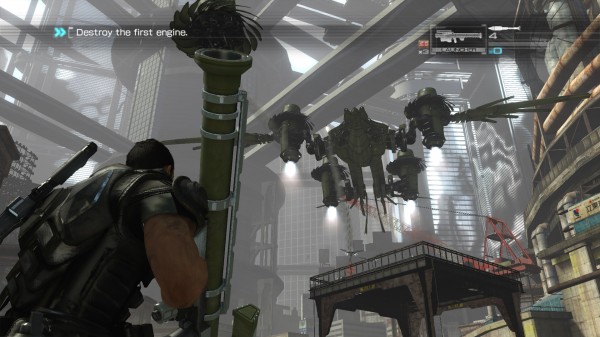
Visuals and Sound
The game is not a spectacular graphical masterpiece, but manages to convey the difference between the game’s clinical, robotic settings and the dirtier, slum city settings well enough. There’s very little slow down, although the screen is never filled with thousands of enemies at once. There is also enough variety in the settings as you move through your mission to be satisfied that the developers weren’t lazy and just generally regurgitating levels.
The cutscenes – while being unnecessarily long at times – tries to drive the story along. However, due to my dislike for the handling of the story and the lack of real emotion in the character’s faces and voices, the cutscenes made me want to label humans the real robots and the robots evolutions of humanity. Skipping them and heading back into the action was very tempting indeed. However, then I’d have to listen to the same repetitive comments from my team mates – once you’ve heard “where did that come from?” for the umpteenth time, your finger will hover over the mute button.
Final thoughts
Binary Domain is a strange game. Or I’m a strange person. There is so much about it I hated, yet I still find myself wanting to play it – and ultimately enjoy it as a guilty pleasure. Maybe I was always hoping for something great to happen, or maybe just ignoring the story helped. Either way, I’d suggest that if you prefer your action in third person rather than first person and want to kill enemies that aren’t of flesh and blood, then Binary Domain is for you. It’s a more than competent third person cover shooter, but a lousy snapshot of humanity.
Zombiegamer rating:
